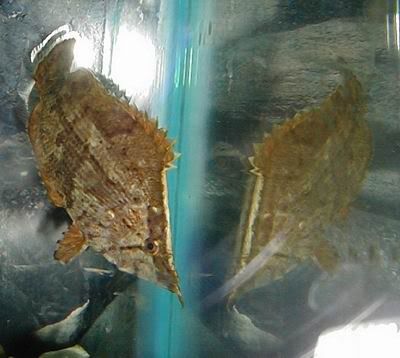
 Common Name:
Common Name: Amazon Leaf Fish
Scientific Name: Monocirrhus polyacanthus
Family: Nandidae (Leaffishes)
Subfamily: Nandinae
Order: Perciformes
Class: Actinopterygii (ray-finned fishes)
Max. size: 10.0 cm
Environment: benthopelagic; freshwater; pH range: 5.0 - 6.0; dH range: 5.0 - 8.0
Climate: tropical; 22 - 25°C
Distribution:South America: Guyana to Brazil. Found in the Peruvian Amazon (Ref. 6329).
Care: Very difficult fish to keep, definitely not for beginners! Monocirrhus polyacanthus are true predators. They are best not accompanied by other fish, although they can be accompanied by diskusfish, angels, and larger Corydoras species. Leaf fish can only be fed live food, juveniles will accept small live food like bloodworms. Older specimens are more picky, and require live fish. They eat approximately their own weight per day, so to keep them properly, you'll need a few tanks in which feeder fish can be bred, or have lot's of money to spend.
A pair can be kept in an 80 cm aquarium, although the larger the better. The tank should be well planted, especially with plants that have large leaves, like Echinodorus species, in between which the leaf fish loves to hide. They are extremely good at hiding, and it will always take some time before you spot them in the aquarium. A dark soil and some floating plants will be appreciated by the fish, but are no necessity. Some driftwood is definitely recommended!
Breeding: At a lower pH(below 6) the fish will spawn in a setup as described in the care section, and if fed well. Up to 300 eggs, which hang by a thread on a leaf, are deposited by the female, and guarded by the male.
At 25 degrees, the eggs will hatch in 4 days, and the fry are around 5 mm. If fed well, they can reach 3 cm in 3 months.
Sexual dimorphism: Recognisable at 4 cm, females display a ovipositor.
Additional Information: Do not use guppies as feeder fish! Many guppies are infected with fishtuberculosis, and leaffish are highly susceptible to TBC, and may contract it through the feeder fish.
Life expectancy: 8-9 years.
References:http://www.nscontact.com/catalogue/-nsc-en_60_51_01_390_1_Monocirrhus_polyacanthus_Amazon.aspxhttp://aquaworld.netfirms.com/Other/Monocirrhus_polyacanthus.htmhttp://www.geocities.com/willowdaleaquariumsociety/library/leaf.html

 Beware, they die easily on you!
Beware, they die easily on you! 





 Originally posted by Fatum:are they good fighters on a hook and line ? ...
Originally posted by Fatum:are they good fighters on a hook and line ? ...








